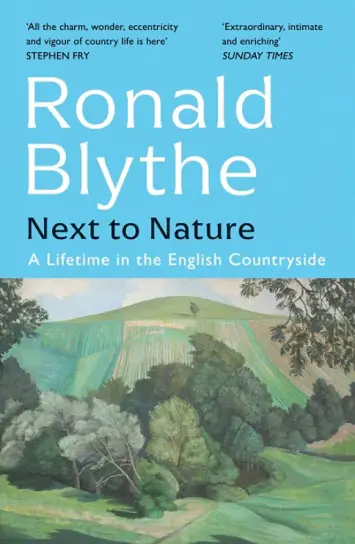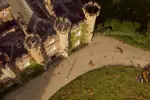Next To Nature: A Lifetime In The English Countryside by Ronald Blythe – Review

By Elizabeth Stanforth-Sharpe
Ronald Blythe died on January 14th, 2023, just two months after celebrating his 100th birthday.
Blythe, the eldest of six children, spent his entire life living within fifty miles of Acton, in rural Suffolk, where he was born into a family of farm labourers. Author and Guardian commentator on natural history, Patrick Barkham, described him as, ‘the greatest living writer on the English countryside’. He left school at 14 with little formal education, was conscripted and served briefly in World War Two, before returning home to work quietly as a reference librarian in Colchester.
His work brought him into contact with local writers, artists, and musicians, and as someone who longed to write himself, he grew in confidence by observing them work and communicate. One of this Suffolk Circle of artists was Christine Kühlenthal, the wife of the painter John Nash, who became a mentor to him, encouraging his writing talent, and helping him to pursue his ambitions. Blythe went on to be employed by E.M. Forster, and influenced by Forster’s work, his first novel, A Treasonable Growth was published in 1960. It was the beginning of a prolific and varied writing career, including thirty more books, always drawing inspiration and enchanting detail from the Suffolk countryside that he loved, but was never fawningly sentimental about.
In the mid-1970s, John and Christine Nash became increasingly frail. Blythe, already living in their home, Bottengoms Farm, lovingly cared for them until their deaths – that of Christine occurring in 1976, followed by John in 1977. John Nash bequeathed the Elizabethan Yeoman’s House – situated in the village of Wormingford and at the end of an overgrown farm track, amidst the rolling countryside of the Stour Valley – to Blythe, who continued to live there until the end of his life. Bottengoms Farm became the subject of a long-running column in the Church Times, ‘Word From Wormingford’, in which Blythe interwove his narratives around the seasons of the year, the liturgical calendar, anecdotes of the celebrated people he had worked with, and his own astute observations of village life, treating all with an extraordinary mixture of detail, reportage, intelligent stripping of unnecessary rhetoric and, what must surely be a methodically filed, eidetic memory of quotes, historical events, facts, and associated emotions. The column ran from 1993 to 2017, engendering a series of books, and Next To Nature, is a celebratory compilation from those volumes of writing, published to coincide with Blythe’s centenary.
The book begins with an introduction by Blythe’s friend, the distinguished writer and broadcaster, Richard Mabey, in which he, rightly, gives a brief biography of Blythe and prepares the reader for what is to come, but what is most touchingly evident is the respect and admiration from Mabey (educated through independent schools and an Alma Mater of St Catherine’s College, Oxford) for Blythe (largely a product of self-education), and the mutual acceptance of unwavering and enduring friendship between the two, despite diverging thoughts on some salient issues. Blythe was a Lay Reader in the Church of England who brushed off suggestions that he might become ordained with the counter-argument that laity have a specific place to play in the work of the church, as part of the quietly gathered congregation, rather than standing outside and above their number – he was ahead of his time; it is only in recent days that the church is slowly opening up to the importance of laity. Mabey claims no organised interest in faith. Blythe’s views on farming and land management occasionally differed from Mabey’s own, but both had the preservation of the countryside and its eco-system at their cores. The things they had in common far outweighed their dissimilarities, and I sensed a deeply warming humility in reading Mabey’s summation of their friendship,
“Many of his scriptural references are as foreign to me as Mandarin, but through the medium of our long friendship I can glimpse common threads in our beliefs: the immemorial virtues of kindness and cooperation, but also of toil; the way the land – be it Palestinian desert or Suffolk prairie farm – moulds us as much as we mould it; the worth and autonomy of all Creation’s beings.’ (Mabey, 2022)
It is an introduction that honours a friendship that is as rare as hen’s teeth, and writing this review following Blythe’s death, my heart goes out to Mr Mabey, who will miss walking and talking along those wildflower strewn pathways and the extraordinary gentleman he had the privilege of knowing so well.
This intriguing work continues by softly carrying the reader through the seasonal rhythms of a year in the Suffolk countryside, setting ‘Word From Wormingford’ columns for the corresponding months from different years alongside each other, bringing a freshness and new vibrance for those who may have read previous collections. From the scent of impending snow in January, through to the farmers browsing seed catalogues as the bells ring in the New Year at the close of the following December, it is a journey that I found myself taking three times over.
On the first read, I struggled to keep up with the sheer lavishness of detail and breadth of observational details. History, literature, memoirs of some of the greatest influences in our land, theology, art, music, agronomy and poetry, set alongside accounts of washing drying on the line, leaving the glasses Blythe struggles to read through in the churchwarden’s car, and the white cat watching the dustbin collector from the vantage point of the brick wall, proved to be a heady, enthralling tangle that made me realise that I was in the literary presence of a writer of tremendous intelligence whose brain moved at a far swifter speed than my own, but had exceptional things to impart.
“Beautifully rich”
 Sensing a need to sit at the feet of this rural Gamaliel and slowly untwist the wisdom in each precious strand, I read for a second time, with a notebook and pen by my side, jotting down facts, quotes, things to enquire further about, and simply to play with the prose. It was in this interaction that, for me, the real appreciation of Next To Nature began. I have heard of devotees of Blythe who use his writing as morning meditation, taking one of the short sections daily and focusing their full attention on it and, with hindsight, I perceive that to be a sensible way of approaching it; after all, the individual pieces were originally presented as short, separate essays, not as a collection, and the content is so beautifully rich and crammed with sensory overload that, like a luxurious chocolate cake, the smallest portion is a feast.
Sensing a need to sit at the feet of this rural Gamaliel and slowly untwist the wisdom in each precious strand, I read for a second time, with a notebook and pen by my side, jotting down facts, quotes, things to enquire further about, and simply to play with the prose. It was in this interaction that, for me, the real appreciation of Next To Nature began. I have heard of devotees of Blythe who use his writing as morning meditation, taking one of the short sections daily and focusing their full attention on it and, with hindsight, I perceive that to be a sensible way of approaching it; after all, the individual pieces were originally presented as short, separate essays, not as a collection, and the content is so beautifully rich and crammed with sensory overload that, like a luxurious chocolate cake, the smallest portion is a feast.
Having unravelled the threads and got a wider grasp of the content, I read a third time, to luxuriate in the wit, reflections and audacious splendour of it all, celebrating the words and language of someone who knew how to observe his world, squeeze every drop of texture, meaning and association from it, and, most importantly for his readers, knew how to translate those considerations to meaningful and elegant prose.
I’ve seen several comments from readers who have attempted to read Next To Nature, but haven’t been able to get to grips with Blythe’s writing voice, abandoning the book quickly. I can understand why, but I would strongly urge anyone to persevere; the treasure is worth digging for, and the more one engages with his narrative and connects to this extraordinary author’s viewpoint of the world, the easier it becomes.
But it isn’t solely Blythe’s writing that makes this work sing. Each month in his year, is prefaced by a brief panegyric by one of twelve individuals saluted in their own fields. Rowan Williams, the 104th Archbishop of Canterbury; Alexandra Harris FRSL, Professor of English at the University of Birmingham; Maggi Hambling, Artist; Frances Ward, theologian, now Priest in Charge of St Michael’s and St John’s Churches in Workington, but formerly the Dean of St Edmundsbury in Suffolk, and of whom Blythe, defending the ordination of women, said, “You couldn’t have a better Dean”; Mark Cocker, author and naturalist; Olivia Laing FRSL, writer and critic; Robert Macfarlane, Fellow and Professor of Environmental Humanities at Cambridge University; Ian Collins, writer and curator; James Hamilton-Paterson, writer and journalist; Julia Blackburn FRSL, writer and teacher; Richard Holloway, theologian, writer, former Gresham Professor of Divinity, Chairman of the Scottish Arts Council, and, Hilary Spurling, arts editor, theatre critic and former literary editor for The Spectator. It is a formidable list of Blythe’s friends and admirers but, as if the reader hasn’t been spoiled enough, there are even more treats – this is a book celebrating a very important birthday, after all.
John Nash’s own fascinating journey as an artist is not the stuff of this review, but his life at Bottengoms Farm is as tenaciously connected with Blythe’s own story as the lichen that we are told clings to his gravestone, for which Blythe chose the inscription. Poignantly, Blythe now lies alongside. The two shared a love of the plants around them, Nash referring to himself as an ‘artist plantsman’, so it is totally fitting to see Nash’s crisp wood engravings of botanical and rural observations interspersed between the pages of Next To Nature, whilst two of his paintings adorn the dust cover.
Before ever opening the book, the reader is pulled into the summertime of a ‘Dorset Landscape’, (executed in 1930 using watercolour, chalk and graphite), standing on a high hill that casts a shadow in the foreground, looking down upon a stream around which a cluster of trees are leaning heavily in the wind, and beyond, another steep hill rises, partly prepared for cultivation, a lone tree standing near the crest. At first glance, it is dreamy; the colour palette pastoral and soothing, but it speaks deeper of the loneliness and harshness of making a living from, and dwelling, in the rural landscape, where tilling can be an upward struggle, and isolation from supportive community can take its toll.
There is almost a prophesy in Blythe’s words as December arrives and he fights against the shortness of daylight hours, determined to complete the task of cutting off the dead limb of the quince tree,
‘But the tree has a history parallel with my own in the wild garden and I sense that I am losing part of myself as the boughs fall…’ (Blythe, 2022)
The Nash wood engraving that closes the December section is of a Bee Orchid, a commonly known British wildflower that is becoming scarce, but is most often found inhabiting the meadows and farmlands of Suffolk. The once common ways are diminishing, as are those who remember and tell their stories. We will not encounter the likes of Ronald Blythe again.
But, lest the reader become maudlin, Vikram Seth, a writer of beautiful description himself, raises an acrostic poem of celebration to Blythe, and as we close this remarkable book leaving behind Blythe’s legacy of words, the author reminds us of the words of Albert Camus, ‘In the depths of winter, I finally learned that within me there lay an invincible summer’. The cover of Next To Nature flips shut, the illuminated sepia shades of Nash’s watercolour, ‘Winter Afternoon’ (1945) glistens, the bright light on the horizon focuses our gaze, and we can sense that, for Blair, summer has come.
‘Next To Nature: A Lifetime in the English Countryside’ is published by John Murray, £12.99 paperback









